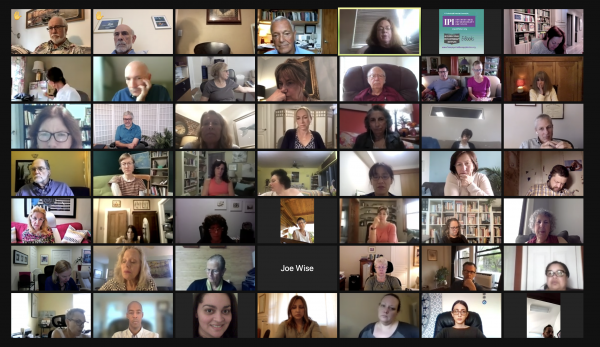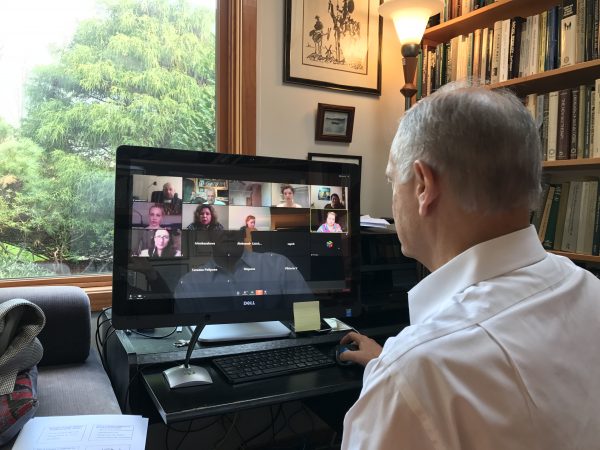David Scharff, MD
Scharff, D. E. (2021). Six Hard-Won Lessons: Teaching Psychoanalysis Online. The American Psychoanalyst, 55(3), 29–30.
The International Psychotherapy Institute (IPI) and its psychoanalytic training program, the International Institute for Psychoanalytic Training (IIPT), were founded as distance learning programs. So, the question of how to conduct effective teaching across geographical distance has always been front and center in its conceptualization of programs and in teaching. I wrote an article for the Journal of the American Psychoanalytic Association about this several years ago (Scharff, 2015) to share what we had learned about effective teaching to students who were not geographically together. But events in the intervening years have overtaken what could be said then, so I am most appreciative to Alan Sugarman for inviting me to update our learning in light of the suddenness with which all institutes and psychotherapy training programs have had to move online, most with little or no preparation.
The first thing to say is that good online teaching is centered in good teaching. If teaching technique does not work well in the in-person classroom, it will not work online either. For instance, a teacher reading from a paper or from lecture notes with her head down for an extended period of time is ineffective in a classroom, and even worse online. Now that we all have experience, it will perhaps come as no surprise that promoting discussion using Zoom – which is the best platform (to my mind) and most common one – can be pretty much as effective as doing so in an in-room class.

IPI has used distance teaching at many levels of scale. In the beginning in 1995, “distance education” meant that all our students had to travel several times a year to join us in Washington, DC. This was expensive for out-of-town students; nonetheless many found it worthwhile because they came from places with no analysts or even analytic psychotherapists from whom to learn. Others came because they wanted access to our particular theoretical orientation in object relations psychoanalysis. Recall that in the 19th and early 20th centuries, Americans wanting to learn psychoanalysis usually went to Vienna or Berlin, and later London. That was only possible because trans-Atlantic travel and travel by rail had improved over the previous decades, making it finally practical to travel long distances. Although the telephone was invented around the turn of the 20th century, calls were too expensive to be useful for treatment, education, or supervision.
Twenty-five years ago, the phone was inexpensive and so we used it for individual supervision, small group “conference call” seminars, and group supervision. And it worked pretty well. We might have wished we could be in a room together, but it was nevertheless satisfying to be sharing ideas and clinical experiences on the phone. Then, in the late 1990s, came the internet, and a subsidiary technology called the “intranet” offering the possibility to link sites for real-time audiovisual communication. It was relatively expensive but could link up to four sites at a price IPI decided to afford. So, we linked Washington, DC with London, Salt Lake City, and Long Island. In that way we could import teaching from London or New York to three American sites where we could gather students. As far as I know, we were the first in our field to do this. One of our board members cautioned me that there was considerable wisdom in being the second group to try something new in order to let someone else work out the bugs; but we forged ahead. Despite the frequent technical glitches, we found that a great deal could be learned working together as a group across the four sites. We partnered with two divisions of the Tavistock, especially the Clinic and the Institute of Marital Studies (now Tavistock Relationships), over several years, sponsoring joint programs with some students on both sides of the Atlantic. And we could use presenters from the New York area, or invited guests, to present at one of the other sites who could then teach to all four via the intranet connection.

And then the technology mushroomed. Suddenly we were able to offer large group seminars to individuals sitting at their own computers in the comfort of their offices or homes. And we could invite guest teachers from anywhere in the world. At first, the available technology was pretty clunky and often subject to disconnection. But, as we all know, with the advent of current platforms (Zoom, Doxy.me, FaceTime, Google Groups) it has “zoomed along.”
Here is what we do now at IPI:
- Large group seminars with all participants able to join in and speak during discussion periods. We do not do webinars because they constitute one-way delivery and therefore, over time, we decided it is the least effective teaching medium. We feel that people learn best when there is discussion in a group of any size. So, we have groups of up to 150 or so. (Our Zoom contracts allow 300 participants without having to buy a more expensive license, although larger group sizes are available.) We ask presenters in our seminar series to present for approximately ½ the time of a seminar. For instance, we ask for a one-hour presentation if the seminar is for two hours, with several pauses throughout the presentation for discussion. That way the audience feels listened to and the presenter receives feedback throughout the presentation. Even though only a minority of participants speak in a large group, the possibility of speaking changes the receptiveness of the entire group. Participants also use the chat function to comment or ask questions. We strongly believe in interactive learning, no matter the size of the audience.
- We use the large group meeting feature for institutional events: Faculty meetings, meetings of our entire center, and Town Halls that draw participants from all over the world (China, Australia, South America, Europe) to discuss issues of mutual concern – racial issues, issues of culture and ethics, COVID and its effects.
- Small group seminars the size of an analytic or psychotherapy class, work well on Zoom. Teachers and students can all see and hear each other well. It is just as possible for a teacher to elicit group discussion on Zoom as it is when students are in-room. We encourage group discussion in these settings and discourage teachers from simply lecturing without time for group participation. That makes real learning of the kind afforded by small seminars entirely possible on zoom.
- COVID travel restrictions have prompted us to offer weekend conferences online. Candidates, students, and other participants work with a distinguished guest and IPI faculty in large and small group settings over three days of intensive learning. Enrollment has steadily increased during the pandemic, in part because these conferences do not require the difficulty, added time and the expense of travel.
- What does not work as well is a so-called “hybrid” classroom with some students in the room and some online. In a preliminary survey done by the APsaA’s Distance Analysis Study Group, a number of candidates complained about seminars with this hybrid mixture. They reported that this approach disadvantaged the distance candidates. Their preference was for “all on-line” or “all in-room”.
- Supervision is especially convenient and effective online. In my own experience, there is no difference in effectiveness between in-room and on-line supervision and consultation. This applies equally to individual, paired and group supervision. I can see my supervisee(s) because I ask them to have their cameras on – unless a broadband weakness requires a disabled camera for improved transmission. Some supervision pairs prefer the telephone; that, too, is effective. Allowing the supervising pair to choose is just as important as it is when doing clinical analysis or psychotherapy.
- The largest downside of distance-mediated education, what we all miss most, is the informal time – meeting in the hallway over coffee or a drink after class. It is possible to make some accommodation for this loss by scheduling a group chat for a class or faculty, but we look forward to being physically together as we creep back to normality. Reinstating the social aspect will be easier because we have stayed in touch online in the meanwhile.

Our hard learned lessons for teaching by internet:
- Always keep in mind the group dynamics.
- Monitor the group: Who is speaking? Is the group participating or only listening passively? Are one or more students hiding out without participating, perhaps helped by turning their camera off?
- Involve the group members. Do you want candidates or students to prepare to present material, for instance from the readings? Or to summarize a topic from their own study? Or to address questions supplied in advance in order to focus their reading?
- Technical glitches will happen! Have you prepared a fallback plan to switch to another platform — FaceTime, Google Groups or cell phone? Be sure to have everyone’s email and phone numbers so you can call or text easily to facilitate connection for a student or faculty member.
- Review with the students how the teaching is going periodically. There should be both formal review by the course or program organizer, and by a given teacher with the group. This is especially important online because there is some diminution in non-verbal cues. But we can make up for that by reviewing the teaching and learning in tactful but overt ways that should be initiated by the teacher. Otherwise, dissatisfaction can accumulate while being expressed only tacitly through resistance like being overly complaint to the teacher or organizers while learning little.
- Finally: Learn to enjoy yourself via the face-to-face connection with students on Zoom. You will have saved commuting time, and have the comfort of your own office, just as they do. While I hear many complaints about “Zoom fatigue”, it does not have to be exhausting! With experience, you can learn to relax during teaching just as you need to relax while conducting therapy. Teaching and supervising should be more than work. They should include the pleasure of helping less experienced colleagues grow. We have had an incredible opportunity to continue to teach and learn in the time of a pandemic. And for sure, this worldwide misadventure will also lead to an expansion of what is possible in the teaching and spread of psychoanalysis after the pandemic recedes.
Reference
Scharff, D. E. (2015) Psychoanalytic Teaching by Video Link and Telephone. Journal of the American Psychoanalytic Association, 63:3 pp. 443-468.
David E. Scharff, MD, is the Co-Founder and Former Director, the International Psychotherapy Institute, and a Supervising Analyst in The International Institute for Psychoanalytic Training, IPI’s analytic program. He is Co-Chair of APsaA’s COVID-19 Advisory Committee and a member of APsaA’s Distance Analysis Study Group. He also directs training programs in China and Russia.

